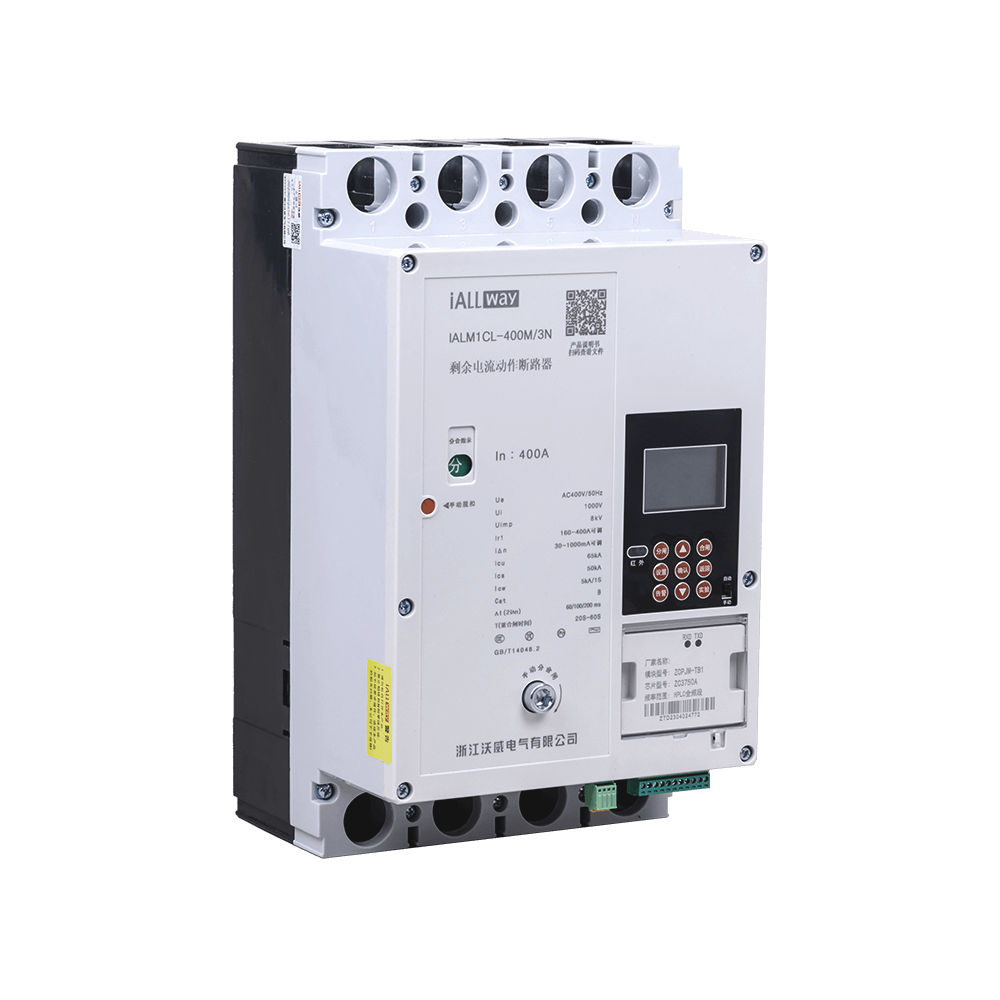Earth Leakage Circuit Breaker
Explore our new ELCB Product Series: Pioneering design, globally acclaimed.
Safeguarding electrical safety for reliable protection in your life and work!
Home » Earth Leakage Circuit Breaker
Explore our new ELCB Product Series: Pioneering design, globally acclaimed.
Safeguarding electrical safety for reliable protection in your life and work!
Home » Earth Leakage Circuit Breaker

iALLWAY Electrical presents cutting-edge Earth Leakage Circuit Breakers (ELCBs), available in 3 poles or 4 poles, designed for optimal electrical safety. Our ELCBs, ranging from 16A to 800A, provide robust protection in AC 50Hz circuits with a rated voltage of up to 400V. With international standards compliance, including GB/T 14048.2 and IEC 60947-2, iALLWAY ELCBs guarantee reliability. The advantages of our 3 pole Earth Leakage Circuit Breaker include:
Global Recognition: IEC and ISO approval, reflecting adherence to international quality standards.
High Breaking Capacity: Ensures stability with a rated limit short-circuit breaking capacity up to 65kA at AC400V.
Long-Term Stability: Designed to withstand time and environmental challenges, ensuring durability.
Discover our most comprehensive content in our catalog – your gateway to a world of possibilities in the ELCB manufacturing industry.
Maintain a stable supply chain for consistent product availability and risk mitigation. Our steadfast approach bolsters our capacity to adapt to changing conditions, ensuring operational continuity and resilience.
iALLWAY ELCB (Earth Leakage Circuit Breaker) finds extensive applications in electrical systems, designed to mitigate the risk of electric shock. Our ELCB protects against electric shock in AC 50Hz circuits, with a rated voltage of up to 400V and a current range of 16A to 800A. Protect your devices from the risk of indirect and supplementary contact. Its applications span industrial, commercial, and residential settings, guarding against overloads, short circuits, and other electrical faults.

Your questions answered
An Earth Leakage Circuit Breaker (ELCB) is a safety device used in electrical installations with high earth impedance to detect small stray voltages on the metal enclosures of electrical equipment and interrupt the power supply to prevent electric shock incidents and ensure the safety of individuals. It detects fault currents from live (hot) to the earth (ground) wire within the installation. When high voltage appears across the ELCB’s sense coil, it switches off the power and remains off until manually reset, thus protecting the electrical system in the building.
ELCBs play a crucial role in ensuring electrical safety in various environments. The advantages of an Earth Leakage Circuit Breaker (ELCB) include:
1.Protection Against Electric Shock:
ELCBs detect and interrupt fault currents to the earth wire, preventing electric shocks and enhancing overall safety.
2.Risk Mitigation in Diverse Environments:
Used in industrial, commercial, and residential settings, addressing the risk of electrical faults in various scenarios
3.Prevention of Indirect and Supplementary Contact Risks:
By interrupting the power supply in unsafe conditions, ELCBs prevent indirect and supplementary contact risks, enhancing overall safety.
4.Fire Hazard Prevention:
ELCBs contribute to fire hazard prevention by detecting faults and interrupting the circuit, reducing the risk of fire incidents caused by electrical faults.
Definition: ELCB is a safety device installed in electrical systems with high earth impedance to prevent electric shock. RCCB is a safety device used in electrical installations, to prevent electric shock from indirect contact.
Device Type: ELCB is a voltage-operated device. RCCB is a current-operated device.
Connection: ELCB is connected to phase, neutral, and earth wires. RCCB is connected only to phase and neutral wires.
Fault Detection: ELCB detects only electrical faults in which earth leakage current flows through the main earth wire. RCCB can detect any type of earth fault.
Working Principle: The working principle of ELCB is based on earth leakage current flowing through the main earth wire. RCCB works based on the core balancing current transformer (CBCT).
Monitoring of Earthing Status: ELCB monitors the earthing status of the system, ensuring a good connection to the ground. RCCB does not monitor the earthing status of the electrical system.
Need for Earth Connection: ELCB requires an earth connection to function. In the case of RCCB, there is no need for an earth connection to function.
Nuisance Tripping: ELCB has less false tripping. RCCB has more false tripping.
How ELCB are Manufactured
ELCB breaker switch manufacturer
iALLWAY
Zhejiang Wowei Electrical Co., Ltd., based in the Yueqing Economic Development Zone, Zhejiang Province, is a leading enterprise specializing in low-voltage electrical appliances, particularly circuit breakers. Their product range includes ELCBs,ACBs, electronic MCCBs, plastic case circuit breakers, and GFCIs, all meeting IEC standards. The company is certified with ISO9001, ISO14001, OHSAS18001, and CCC standards, reflecting their commitment to quality.
providing robust protection for various applications
More than just ELCBs, we provide comprehensive solutions. From consultation and design to manufacturing, delivery, and ongoing support, we stand by your electrical safety needs.

Explore a Complete Electrical Solution Hub;
Connect with iALLway for premium ELCBs in industrial and commercial settings. Request Your Quick Quote Now!
What is an Earth Leakage Circuit Breaker?
An Earth Leakage Circuit (ELC), also known as an Earth Leakage Circuit Breaker (ELCB) or Residual Current Device (RCD), is a crucial electrical safety device designed to protect people and property from electrical faults and the risk of electric shock. It operates by monitoring the electrical current flowing through a circuit and detecting any imbalance between the current entering and leaving the circuit.
ELCs are essential in residential, commercial, and industrial settings to protect against electrical faults. They are especially crucial in damp or wet environments, where the risk of electrical leakage is higher. By quickly disconnecting the power supply when a fault is detected, ELCs play a vital role in preventing accidents and ensuring electrical safety.
Types of ELCBs
Voltage Earth Leakage Circuit Breaker – Voltage ELCBs are voltage operated. This ELCB works with the aid of a relay coil that is connected to a metal body. The other end of this coil is connected to the ground. To understand how voltage ELCBs work, let’s dig deeper into understanding voltage fluctuations.
If the voltage of equipment rises, maybe because of limited insulation, then this leads to a difference between the earth’s voltage and the voltage of the equipment. This discrepancy then causes an electric current to pass from the load metal framework to the earth. When a voltage operated earth leakage circuit breaker is installed, these current faults are detected in real-time. If a voltage ELCB detects a certain voltage across its coil, then it will automatically turn off. This will prevent any earth leakages and eliminate the chances of shock. You can always manually reset the voltage – ELCB to make it function again.
To summarise, Voltage-ELCBs monitor the voltage on the relay coil connected to the earth and immediately shut off the electrical supply if the voltage crosses 50 volts.
– Advantages of voltage operated earth leakage circuit breakers
Aid in the prevention of electrical shocks
These are less sensitive and hence do not trip unnecessarily.
In comparison to current ELCBs, these are less expensive.
– Disadvantages of voltage operated earth leakage circuit breakers
These do not prevent electrical shocks in instances where someone touches the phase conductor directly.
This only trips when the leakage current flows through the conductor.
Voltage ELCBs require an extra connection with the equipment body and earth.
Due to its reduced sensitivity, there are instances where these cannot detect low levels of leakage current.
Some equipment usually leaks voltages and such equipment can then trip the ELCBs, leading to false alarms.
Current Earth Leakage Circuit Breaker – These are the more commonly used ELCBs and are also known as RCCB (Residual Current Circuit Breakers). These ELCBs are built differently from voltage ELCBs. The core mechanism of a current ELCB consists of three winding transformers, with two primary windings and one secondary winding. These windings are made of phase, neutral, and wire-wound coils, respectively. These are collectively called the Core Balance Current Transformers (CBCT).
The current through the secondary winding, at its balanced state, is zero. This is known as the normal state and at this stage, the ELCB isn’t activated. When a electric fault does occur, it also flows to the ground. This creates an unbalanced magnetic field which is detected by the phase and neutral winding wires. This triggers a message to the secondary winding wire, which is connected to the sensing circuit. Hence, the fault is detected and a signal then trips the current.
– The Advantages of Earth Leakage Circuit Breaker
The Current ELCB breaks supply to the complete circuit if power leaks from any part of the circuit.
These are considered highly reliable when it comes to protection against electrical shocks.
These have higher sensitivity and hence can detect minute anomalies and abnormalities.
The current ELCBs have a consistent monitoring mechanism in place. This enables the device to break the electrical supply when the current threshold is exceeded.
These do not require an earth connection.
Related Article: TYPES OF CIRCUIT BREAKERS AND THEIR IMPORTANCE
– The Disdvantages of Earth Leakage Circuit Breaker
If ELCBs are used with older appliances with a small leakage, then these may trip unnecessarily owing to their sensitivity.
These are more expensive than voltage-based ELCBs.
These ELCBs do not offer overload protection.
These offer no protection against short circuits.
Overall, though, you will benefit more by investing in a current ELCB or RCCB instead of a voltage operated earth leakage circuit breaker. This is because voltage-based ELCBs function on redundant technology that offers very limited protection as compared to RCCBs. While current-based ELCBs may be more expensive, these are a more reliable option when it comes to protecting your space from earth leakages and short circuits.
Working Principle of Earth Leakage Circuit Breaker ELCB
The working principle of an ELCB is based on detecting ground faults or leakage currents and rapidly interrupting the circuit’s power supply to prevent harm.
Here’s how an ELC works
Current Monitoring: The ELC continuously monitors the current in both the live (phase) and neutral wires of an electrical circuit. In a balanced circuit, where the current entering and leaving the circuit is equal, there is no leakage current.
Detection of Leakage: If a ground fault or leakage current occurs, due to damaged insulation or contact with live conductors, an imbalance in the currents is detected. The ELCB has a built-in sensing coil or toroid that detects this imbalance.
Differential Current Comparison: The ELCB compares the currents in the live and neutral conductors. If there is a difference exceeding a preset threshold (usually a very small value, often just a few milliamperes), it indicates a leakage current.
Rapid Interruption: When an imbalance is detected, the ELC rapidly opens the circuit by tripping a switch or breaker. This action interrupts the flow of electricity and prevents potential electric shock or fire hazards.
ELCBs come in two main types
voltage-operated ELCBs (VO-ELCBs)
current-operated ELCBs (CO-ELCBs)
VO-ELCBs rely on voltage imbalances to detect ground faults, while CO-ELCBs use current imbalance detection, making them more sensitive and widely used today.
FAQ:
Is it necessary to install earth leakage circuit Breakers (ELCB)?
Yes, it is strongly recommended to install Earth Leakage Circuit Breakers (ELCBs) or Ground Fault Circuit Interrupters (GFCIs) in electrical circuits, especially in locations where electrical safety is paramount. These devices are crucial for protecting against electric shock and preventing electrical fires caused by ground faults or leakage currents. ELCBs provide an added layer of safety by rapidly disconnecting power when such faults occur, minimizing the risk of harm to individuals and property. Their installation is a fundamental safety measure and is often mandated by electrical codes and regulations in many regions.
What is medium-sensitivity Earth Leakage Circuit Breaker?
A medium-sensitivity Earth Leakage Circuit Breaker (ELCB) is an electrical safety device designed to detect and respond to ground faults or leakage currents with a moderate sensitivity threshold. Unlike high-sensitivity ELCBs that can detect even small leakage currents (e.g., 10 milliamperes), medium-sensitivity ELCBs typically have a sensitivity threshold in the range of 30 to 300 milliamperes. These devices are commonly used in electrical installations where a slightly higher level of leakage current is acceptable, such as in industrial settings or for specific applications where a high-sensitivity ELCB might lead to false tripping. Medium-sensitivity ELCBs provide a balance between safety and practicality in various electrical systems.
Can ELCB be connected in reverse?
No, an Earth Leakage Circuit Breaker (ELCB) should never be connected in reverse. ELCBs are designed to be installed in a specific orientation to function properly and ensure electrical safety. The current sensing coil or toroid within the ELCB is configured to detect imbalances between the current in the live and neutral conductors. If it’s installed in reverse, it won’t operate as intended and may not detect ground faults or leakage currents accurately. Incorrect installation can lead to electrical hazards and a false sense of security.
Share this post, Hit on social buttons!


No WhatsApp Number Found!

 English
English Arabic
Arabic Portuguese
Portuguese Spanish
Spanish Russian
Russian French
French Turkish
Turkish